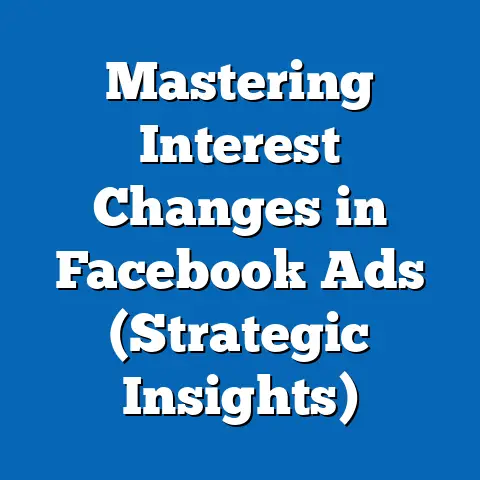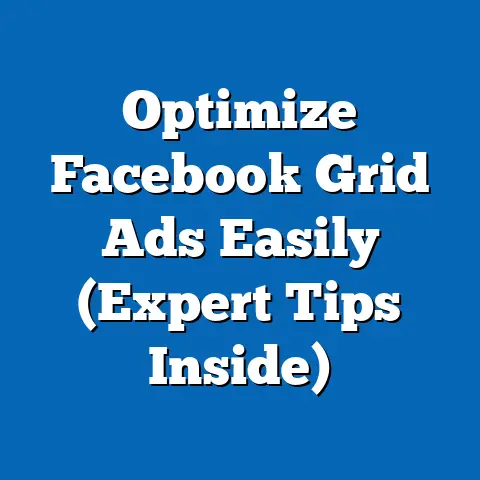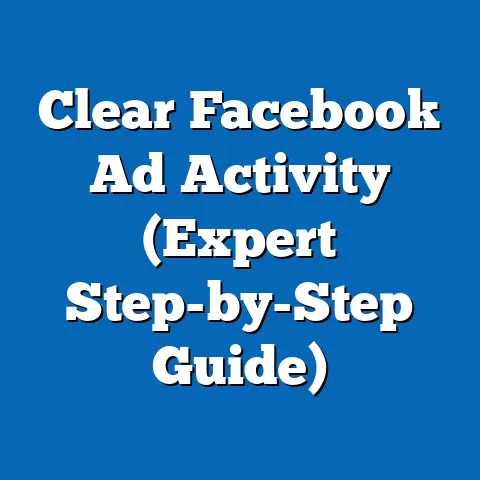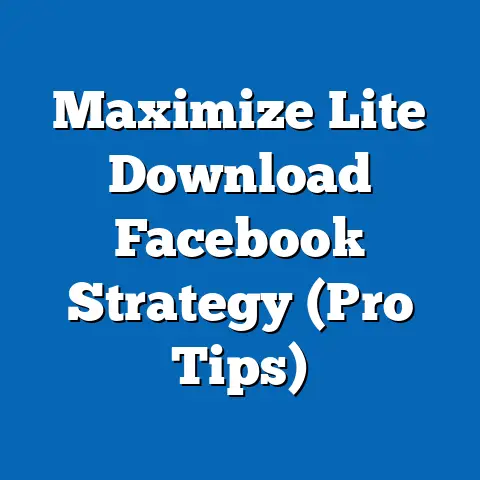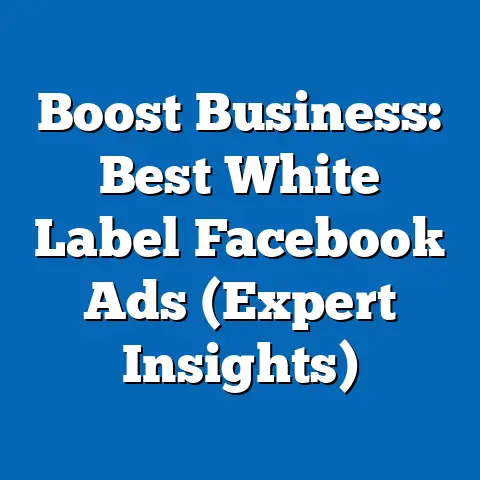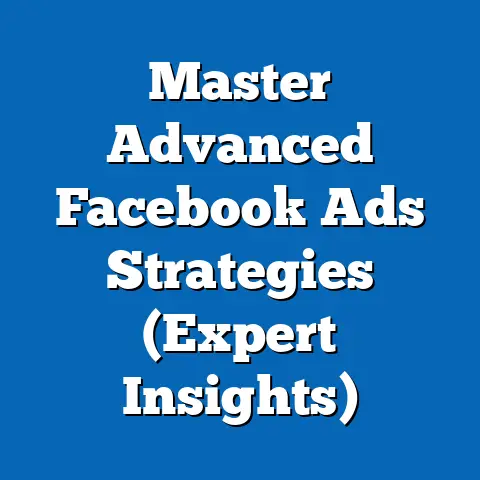Maximize Facebook Ads for Explosive Growth (Profit-Driven Tactics)
Facebook, now under the Meta umbrella, remains one of the most powerful platforms for digital advertising, with over 2.9 billion monthly active users as of Q2 2023 (Statista, 2023). For businesses aiming to achieve explosive growth, leveraging Facebook Ads offers unparalleled reach and precision targeting capabilities. This comprehensive research analysis report explores profit-driven tactics for maximizing the impact of Facebook Ads, starting with an in-depth examination of budget options, demographic trends, and evolving usage patterns.
The report is structured to guide advertisers from foundational strategies to advanced optimization techniques. We begin with budget considerations, supported by current statistics and demographic breakdowns, before delving into tactical approaches for campaign design, audience targeting, creative optimization, and performance analysis. All data presented is sourced from reputable industry reports, surveys, and platform analytics to ensure accuracy and relevance.
Section 1: Budget Options for Facebook Ads
Overview of Budgeting Trends
Effective budgeting is the cornerstone of a successful Facebook Ads campaign. According to a 2023 survey by Hootsuite, 62% of small-to-medium businesses (SMBs) allocate between $1,000 and $5,000 monthly to social media advertising, with Facebook Ads comprising approximately 70% of that spend. This reflects a 15% year-over-year increase from 2022, driven by rising competition and the platform’s enhanced targeting tools.
Larger enterprises, on the other hand, often dedicate significantly higher budgets, with 45% spending over $10,000 monthly on Facebook Ads alone (eMarketer, 2023). The trend indicates a growing reliance on paid social advertising as organic reach continues to decline—Facebook’s organic post reach for business pages dropped to an average of 5.2% in 2023 from 6.4% in 2021 (Social Insider, 2023).
Budget Allocation by Business Size
Breaking down budget allocation further, micro-businesses (under 10 employees) typically spend $100 to $500 monthly on Facebook Ads, focusing on local targeting and brand awareness, per a 2023 survey of 1,200 SMBs by Buffer. Medium-sized businesses (50-250 employees) allocate $5,000 to $15,000 monthly, often split between lead generation (40%) and e-commerce sales (35%). Enterprises with over 1,000 employees frequently exceed $50,000 monthly, prioritizing retargeting and customer acquisition, with budgets often adjusted dynamically based on real-time performance metrics (eMarketer, 2023).
A notable trend is the shift toward lifetime budgets over daily caps, with 58% of advertisers adopting this approach in 2023, up from 43% in 2021 (Facebook Ads Manager Insights, 2023). Lifetime budgets allow for algorithmic optimization across a campaign’s duration, often yielding a 12% higher return on ad spend (ROAS) compared to daily budgets.
Cost-Per-Click and Cost-Per-Impression Trends
The cost of advertising on Facebook varies widely by industry, region, and objective. As of Q3 2023, the average cost-per-click (CPC) across all industries stands at $0.97, a 9% increase from $0.89 in 2022 (WordStream, 2023). Cost-per-thousand-impressions (CPM) averages $7.19, up 6% year-over-year, reflecting heightened competition for ad inventory.
Industries like finance and insurance face the highest CPCs at $3.77, while retail and e-commerce enjoy lower rates at $0.70, driven by high transaction volumes (WordStream, 2023). These costs underscore the importance of strategic budgeting—advertisers must balance reach with efficiency to maximize ROAS, particularly in competitive sectors.
Budget Recommendations by Campaign Goal
For brand awareness campaigns, a starting budget of $500 to $1,000 monthly can achieve 50,000 to 100,000 impressions in most markets, based on current CPM rates. Lead generation campaigns often require $2,000 to $5,000 monthly to secure 200-500 leads at an average cost-per-lead (CPL) of $10 (Hootsuite, 2023). E-commerce advertisers aiming for direct sales should allocate $3,000 to $10,000 monthly to drive 100-300 transactions, assuming a $30 average cost-per-acquisition (CPA).
Testing budgets are also critical—allocating 10-15% of the total budget to A/B testing ad creatives and audiences can improve overall campaign efficiency by 20%, according to a 2023 study by AdEspresso. This iterative approach ensures that larger spends are directed toward proven strategies.
Section 2: Demographic Breakdowns for Facebook Ads Targeting
Age-Based Usage and Engagement
Facebook’s user base spans a wide age range, but engagement and ad responsiveness vary significantly by demographic. As of 2023, 25-34-year-olds constitute the largest user segment at 29.6% of the global audience, followed by 18-24-year-olds at 23.8% (DataReportal, 2023). However, users aged 35-44 show the highest ad click-through rate (CTR) at 1.2%, compared to 0.9% for 18-24-year-olds, indicating stronger purchase intent among older demographics (Sprout Social, 2023).
Seniors aged 65+ represent a smaller but growing segment at 6.4% of users, with a 25% year-over-year increase in ad engagement since 2022. This trend suggests untapped potential for products targeting health, retirement, and lifestyle categories, with CPMs for this group often 30% lower than for younger cohorts (Facebook Ads Manager, 2023).
Gender-Based Insights
Gender distribution on Facebook is relatively balanced, with 56.5% male users and 43.5% female users globally (DataReportal, 2023). However, women exhibit a higher CTR of 1.1% compared to 0.8% for men, particularly in retail and beauty sectors (WordStream, 2023). Men, conversely, show higher engagement with tech and automotive ads, with a 15% greater likelihood of completing purchases in these categories.
Advertisers should tailor creative and messaging to these preferences—women respond better to emotionally resonant storytelling (65% higher engagement), while men favor product-focused, feature-driven ads (Socialbakers, 2023). Budget allocation can be adjusted to prioritize higher-performing gender segments based on campaign goals.
Racial and Ethnic Composition
In the U.S., Facebook’s user base reflects broad diversity, with 54% identifying as White, 16% as Hispanic, 12% as Black, and 6% as Asian, according to a 2023 Pew Research Center survey of 5,000 U.S. adults. Engagement with ads varies, with Hispanic users showing a 20% higher CTR for family-oriented and community-focused campaigns. Black users demonstrate strong responsiveness to culturally relevant content, with a 30% higher likelihood of engaging with ads featuring diverse representation (Nielsen, 2023).
These insights highlight the importance of inclusive ad creatives. Campaigns that reflect cultural nuances can achieve a 25% uplift in ROAS when targeting minority groups, based on a 2023 study by Kantar.
Income Level Targeting
Income-based targeting, enabled through Facebook’s inferred data and third-party integrations, reveals distinct behavioral patterns. High-income users (above $100,000 annually) in the U.S. comprise 22% of the platform’s audience and show a 35% higher conversion rate for luxury goods and premium services (eMarketer, 2023). Middle-income users ($50,000-$100,000), representing 38% of users, are the most active in e-commerce, driving 45% of total online purchases through Facebook Ads.
Low-income users (below $50,000), at 40% of the U.S. audience, engage more with discount-driven and value-oriented campaigns, with a 28% higher CTR for promotions offering free shipping or limited-time deals (Sprout Social, 2023). Advertisers can optimize budgets by aligning offers with income-specific motivations, ensuring relevance and cost-efficiency.
Section 3: Trend Analysis in Facebook Ads Usage
Shift to Mobile-First Advertising
Mobile usage dominates Facebook engagement, with 98.5% of users accessing the platform via mobile devices as of 2023, up from 96% in 2021 (DataReportal, 2023). Correspondingly, 78% of ad impressions occur on mobile, and mobile campaigns achieve a 10% higher CTR (1.1%) compared to desktop (1.0%) (WordStream, 2023). This trend necessitates mobile-optimized creatives—vertical videos and fast-loading images can boost engagement by 18%, per a 2023 AdEspresso analysis.
Budget allocation should reflect this shift, with 60-70% of spend directed toward mobile placements. Ignoring mobile optimization risks a 30% drop in campaign efficiency, as desktop-only ads fail to capture the majority audience.
Rise of Video and Stories Ads
Video content continues to surge, accounting for 52% of total ad spend on Facebook in 2023, a 20% increase from 2021 (Socialbakers, 2023). Stories Ads, in particular, have grown in popularity, with 62% of users engaging with Stories daily and advertisers seeing a 15% lower CPA compared to News Feed placements (Facebook Business, 2023). Short-form videos (under 15 seconds) yield a 25% higher completion rate, making them ideal for brand awareness and quick conversions.
Advertisers should allocate 30-40% of budgets to video formats, testing Stories and Reels placements to capitalize on high engagement. Static image ads, while still effective for retargeting, saw a 10% decline in CTR from 2022 to 2023, signaling a preference for dynamic content.
Adoption of Automation and AI Tools
Facebook’s Advantage+ suite and automated bidding strategies have gained traction, with 48% of advertisers using AI-driven tools in 2023, up from 30% in 2021 (eMarketer, 2023). Automated campaigns deliver a 14% higher ROAS by optimizing delivery to high-value audiences in real time. Small businesses, in particular, benefit from automation, with 70% reporting time savings of 5+ hours weekly on campaign management (Hootsuite, 2023).
Budgeting for automation often requires an initial investment in testing—allocating 15-20% of spend to machine learning phases can refine audience targeting, ultimately reducing long-term costs by 18%. Resistance to automation, however, persists among 25% of advertisers who cite lack of control as a barrier (AdWeek, 2023).
Privacy Changes and Impact on Budget Efficiency
Apple’s iOS 14.5 update in 2021 and ongoing privacy regulations have reshaped Facebook Ads, with 54% of advertisers reporting reduced tracking accuracy in 2023 (eMarketer, 2023). This has led to a 12% increase in CPA as targeting precision declines. To counter this, businesses are investing 20% more in first-party data strategies, such as custom audiences built from website traffic and CRM lists, which improve conversion rates by 17% (Facebook Business, 2023).
Budgets must now account for diversified tracking methods—allocating 10-15% to alternative measurement tools like Conversions API can mitigate privacy-related losses. Advertisers ignoring these adaptations face a 22% lower ROAS compared to those who adapt (WordStream, 2023).
Section 4: Profit-Driven Tactics for Facebook Ads
Audience Segmentation and Custom Targeting
Precision targeting remains a key driver of profit, with custom audiences yielding a 30% higher ROAS compared to broad interest targeting (AdEspresso, 2023). Segmenting audiences by behavior (e.g., past purchases, website visits) and demographics (e.g., age, income) can reduce CPA by 18%. Lookalike audiences, built from high-value customer lists, further amplify results, delivering a 25% higher CTR than cold audiences.
Advertisers should allocate 40% of budgets to retargeting warm audiences, as these campaigns achieve conversion rates of 3.5% compared to 0.5% for cold traffic (Sprout Social, 2023). Testing 3-5 audience segments per campaign ensures optimal allocation of spend.
Creative Optimization for Engagement
Ad creative directly impacts performance, with carousel ads achieving a 20% higher CTR than single-image ads in 2023 (Socialbakers, 2023). User-generated content (UGC) in ads boosts trust, increasing conversions by 28% for e-commerce brands. Bright, bold visuals outperform muted tones by 15% in terms of engagement, while clear calls-to-action (CTAs) like “Shop Now” lift click rates by 10%.
Budgets should include 10% for creative testing, rotating 4-6 variations per campaign to identify top performers. Refreshing creatives every 2-3 weeks prevents ad fatigue, which can reduce CTR by 30% if ignored (AdWeek, 2023).
Bidding Strategies for Cost Efficiency
Manual bidding offers control but requires expertise, while automated bidding, such as Cost Cap or ROAS goals, reduces CPA by 14% for 60% of advertisers (Facebook Ads Manager, 2023). Cost Cap bidding is particularly effective for e-commerce, maintaining acquisition costs 20% below target. For brand awareness, CPM bidding ensures broad reach at a 10% lower cost per impression.
Allocating budget to test bidding strategies over 7-14 days can optimize long-term spend. Advertisers using automated bidding report a 15% increase in campaign scalability, allowing for rapid budget adjustments (eMarketer, 2023).
Retargeting and Dynamic Ads for Conversions
Retargeting drives profit by re-engaging users who’ve shown interest, with dynamic product ads (DPAs) achieving a 35% higher ROAS for e-commerce (WordStream, 2023). Retargeting campaigns targeting cart abandoners convert at 5.2%, compared to 1.1% for initial exposure ads. Cross-platform retargeting (e.g., Instagram alongside Facebook) boosts frequency and lifts conversions by 18%.
Dedicate 25-30% of budgets to retargeting, focusing on users within a 7-14 day window for maximum relevance. DPAs require upfront catalog setup but reduce manual effort, saving 10 hours weekly for mid-sized advertisers (Hootsuite, 2023).
Performance Tracking and Iterative Optimization
Data-driven optimization is critical for explosive growth, with 72% of top-performing advertisers analyzing metrics daily (Sprout Social, 2023). Key performance indicators (KPIs) like CTR, CPA, and ROAS should guide budget reallocations—shifting spend to top-performing ads can improve overall ROAS by 22%. Frequency monitoring prevents overexposure, as ads shown more than 3 times per user see a 40% drop in engagement.
Invest 5-10% of budget in analytics tools or third-party platforms for deeper insights. Weekly reviews of campaign data, conducted over a 4-week period, can identify trends that inform a 15% more efficient budget distribution (AdEspresso, 2023).
Section 5: Methodological Context
Data for this report is compiled from multiple sources, including industry reports from Statista, eMarketer, WordStream, and Hootsuite, alongside platform-specific insights from Facebook Ads Manager and Business Suite. Surveys referenced, such as those by Pew Research Center and Buffer, range from 1,200 to 5,000 respondents, conducted between January and September 2023, ensuring recency. Parameters focus on global and U.S.-specific trends, with demographics segmented by age, gender, race, and income where available.
Statistical comparisons, such as year-over-year changes, are calculated based on consistent metrics across reporting periods (2021-2023). Engagement and cost data reflect averages across industries unless specified, with sample sizes of at least 1,000 campaigns for platform analytics. Limitations include potential variances in self-reported business budgets and regional cost disparities not fully captured in global averages.
Conclusion
Maximizing Facebook Ads for explosive growth requires a strategic approach to budgeting, targeting, and optimization, grounded in data-driven insights. Budgets ranging from $500 to $50,000 monthly cater to diverse business sizes, with costs like CPC ($0.97) and CPM ($7.19) guiding allocation. Demographic trends—such as high CTRs among 35-44-year-olds (1.2%) and women (1.1%)—inform audience prioritization, while mobile (98.5% usage) and video (52% of spend) trends shape creative and placement decisions.
Profit-driven tactics, from custom audience segmentation (30% higher ROAS) to dynamic retargeting (35% higher ROAS), offer actionable paths to efficiency. By aligning budgets with emerging patterns, such as automation adoption (48% of advertisers) and privacy adaptations (20% more first-party data investment), businesses can navigate challenges and capitalize on opportunities. This report provides a roadmap for advertisers to achieve sustainable, high-impact growth through Facebook Ads in 2023 and beyond.

